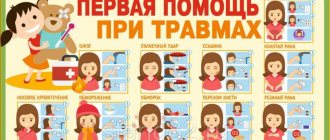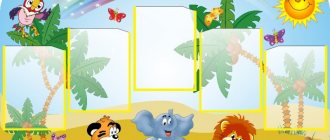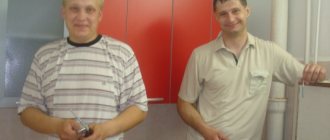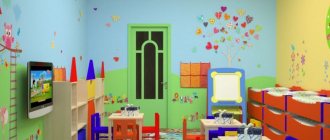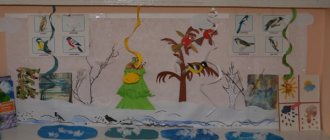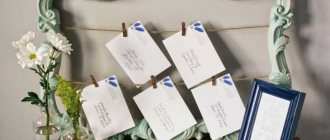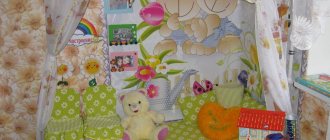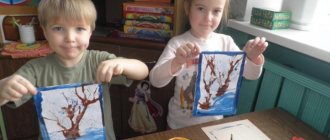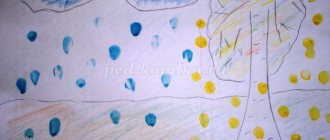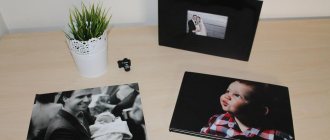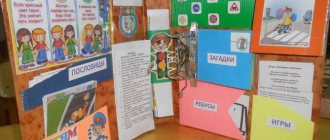Where to arrange an exhibition corner and what needs to be taken into account?
Traditionally, the design of a corner in a kindergarten can consist of several components: the design of an exhibition of children's drawings in the locker room and a corner with materials and visual aids in the group room. However, experts consider it optimal to organize an art studio in a separate room, or to use temporarily free ones - a locker room, a hall, a corridor, and so on.
Our creativity
The developmental environment for visual arts is located in any place convenient for children. It is important that children feel like owners of toys and have free access to art materials and visuals. A prerequisite is a high level of design and aesthetics, as well as flexible use of preschool and preschool space. An exhibition of children's works is most often arranged in the locker room or near the exit from the group room in order to introduce parents to the creativity of their children. It is designed in the form of a stand, most often with tracks made of fishing line, on which drawings are hung using paper clips.
Why design a corner for visual arts and what should be there?
Art corners allow you to create optimal conditions in a group for the development of visual activity, independence and creative activity of children. Children get the opportunity to express themselves in various types of artistic and design activities, get acquainted with the world around them, learn the properties of objects, and so on.
The theater corner in a kindergarten should also be located in close proximity to the visual arts corner, because not only materials characteristic of the theater are placed there (screens, dolls, costumes, etc.), but also some materials for familiarizing oneself with the environment and fiction. It also includes “theatres” and characters made by the children themselves during art classes. The theater corner in kindergarten also includes: a table theater, sets of dolls, costumes, books, materials for decorations.
The art corner, the theater corner and the music corner are located close to each other. Screens and partitions can help rationally organize these spaces. Thus, with a skillful combination of different types of art in each group, you can create a real corner of creativity in kindergarten.
(teacher, Eva Vrezhovna Yaralyan)
Creating a fine arts corner in a kindergarten group creates a favorable environment for children’s creative activity and promotes the emergence and development of independent artistic activity in preschool children.
The modern design of a fine arts corner in a kindergarten may consist of an exhibition of children's drawings in the locker room and a corner with materials, visual aids, colorful drawings and thematic attributes directly in the group.
Let's first consider the design of the corner in the group.
The most important thing is that the art activity corner, the developmental environment in the kindergarten, should be located in a clear, optimal, convenient, accessible place for children. It is important that children feel like owners of toys, have free access to artistic and creative materials. A prerequisite is a high level of design and aesthetics, as well as flexible and expanded use of the organized space of the corner.
Art corners in kindergarten help create optimal conditions in the group for the development of visual activity, independence and creative activity of children. Children get the opportunity to express themselves in various types of artistic and design activities, get acquainted with the world around them, learn the properties of objects, colors, correlate the concepts “object-color”, etc.
It is recommended that in the corner there should be a table with a lid or an easel, all kinds of paints, brushes, paper of different formats and textures, sponges, rags for hands and hands, paint palettes, jars for water, aprons, materials for modeling, in general everything, which will contribute to the artistic development of the child. If possible, it is better to place materials in a closet or special bedside table.
For clarity, reproductions, paintings, portraits of artists, arts and crafts, and folk art (haze, Gzhel, Khokhloma) should also be placed in the corner for clarity. There it is also necessary to place various didactic games to introduce children to various directions and genres - still life, portrait, landscape; with painting, graphics, decorative and applied arts, architecture; with flowers and their shades.
The teacher needs to introduce children to the corner of fine arts:
1. Tell about its structure and direct purpose,
2. Teach children to look at pictures, creative materials and other attributes only there;
3. Tell the children the rules to follow regarding the iso-corner:
Take albums, reproductions, portraits only with clean hands;
Flip carefully;
Do not tear, crush, or use for games;
After looking at it, always put the book or picture back in its place.
Before you start decorating, think about what you will place and where, what components you cannot do without. Achieve aesthetics and relevance in design.
Let's summarize: the main and important conditions for the design of iso-corners for all kindergarten groups are:
1. Optimal location of the visual arts area: accessibility, aesthetics, mobility, safety;
2. Using notes of a “child’s hand” in design;
3. Availability of works of art, compliance with age requirements;
4. Availability of visual material: variety, age requirements, accessibility;
5. Availability of equipment for drawing, modeling, appliqué;
6. Don’t neglect working with color and lines;
7. Use of various techniques of visual creativity, compositions;
8. Presence of folk arts and crafts;
9. Demonstration of various genres of painting, clay samples; artistic handicrafts;
10 Organization of work with children outside the area of artistic and aesthetic development - long-term plans.
The design of the corner may be different for each teacher. The main thing is an individual approach, clarity, and compliance with age norms. The rest depends on the creativity and imagination of the preschool teacher.
Let's consider the issue of design and storage of children's work.
In order to introduce parents to the creativity of their children, exhibitions of children's works should be arranged in the locker room or in close proximity to the exit from the group room. Design options can be very diverse. For example, you can offer an option where crafts are displayed on a stand, perhaps with paths made of fishing line, on which drawings are hung using paper clips and other improvised materials.
The value of the ISO corner in the preschool educational institution
The manual may be aimed at a more detailed study of a specific painting, for example, Khokhloma.
Suitable furniture is important for equipping an art corner in a group. The ideal option is a small shelving unit with a bedside table at the bottom.
It is better to put paper, brushes, glue and other materials in the nightstand, and albums, reproductions, decorative toys and dishes are placed on open shelves.
It is good to put a special table in the art area for creative activities of preschoolers. Sometimes it is combined with a rack.
If the group is small, then it is not necessary to allocate a special table for drawing. The child simply takes the materials he needs and sits down in any convenient place. If you don't have enough space, you can also use miniature corner shelving.
An ordinary bookcase and hanging shelves can also help out.
You can also place an easel in the art corner (so that the children feel like real artists).
Another important component (although not obligatory) of the art corner in the group is a stand for children’s work.
The child can hang his drawing there so that the teacher and other children can admire it. You can make such a thing with your own hands - from an ordinary mosquito net for windows. Decorative buttons are inserted onto the sides and colored laces are pulled over them. The designs are secured to the laces with small clips.
An important part of organizing an art activity center is its aesthetic and original design.
This is where the teacher can show all his imagination and passion for the profession. Modern furniture for kindergartens is often beautiful in itself and painted in colorful tones, but if the cabinet is quite simple, the teacher can transform it with a picture or a bright sticker, for example, a cheerful caterpillar whose body is painted in all the colors of the rainbow.
An excellent decorative option is children's work using non-traditional techniques, decorated with an unusual frame.
If the fine art area is located near a window, then it can also be decorated thematically, for example, with voluminous multi-colored pencils with anthropomorphic features.
In early preschool age, when there is not yet a lot of material in the art corner, you can use hanging shelves and a small bookcase
You can also place an easel in the art corner (so that the children feel like real artists).
Children can draw not only on the table, but also on a special easel
Another important component (although not obligatory) of the art corner in the group is a stand for children’s work.
The child can hang his drawing there so that the teacher and other children can admire it. You can make such a thing with your own hands - from an ordinary mosquito net for windows. Decorative buttons are inserted onto the sides and colored laces are pulled over them. The designs are secured to the laces with small clips.
Preview:
“The importance and content of the art corner in groups.
Registration and storage of children's works"
(teacher, Eva Vrezhovna Yaralyan)
Slide No. 2: Creating a fine arts corner in a kindergarten group promotes an environment for children’s creative activity and promotes the emergence and development of independent artistic activity in preschool children.
Slide No. 3: Modern design of a fine arts corner in a kindergarten may consist of setting up an exhibition of children’s drawings in the locker room and a corner with materials, visual aids, colorful drawings and thematic attributes directly in the group.
Let's first consider the design of the corner in the group.
Slide No. 4: The most important thing is that the art activity corner, the developmental environment in the kindergarten, should be located in a visual, optimal, convenient, accessible place for children. It is important that children feel like owners of toys, have free access to artistic and creative materials. A prerequisite is a high level of design and aesthetics, as well as flexible and expanded use of the organized space of the corner.
Slide No. 5: Fine art corners in kindergarten help create optimal conditions in the group for the development of visual activity, independence and creative activity of children. Children get the opportunity to express themselves in various types of artistic and design activities, get acquainted with the world around them, learn the properties of objects, colors, correlate the concepts “object-color”, etc.
Slide No. 6-13: It is recommended that in the corner there should be a table with a lid or an easel, all kinds of paints, brushes, paper of different formats and textures, sponges, cloths for hands and hands, paint palettes, jars for water, aprons, materials for modeling, in general, everything that will contribute to the artistic development of the child. If possible, it is better to place materials in a closet or special bedside table.
Slide No. 14-15: For clarity, reproductions, paintings, portraits of artists, arts and crafts, folk art (haze, Gzhel, Khokhloma) should also be placed in the corner. There it is also necessary to place various didactic games to introduce children to various directions and genres - still life, portrait, landscape; with painting, graphics, decorative and applied arts, architecture; with flowers and their shades.
Slide No. 16: The teacher needs to introduce children to the corner of fine arts:
1. Tell about its structure and direct purpose,
2. Teach children to look at pictures, creative materials and other attributes only there;
3. Tell the children the rules to follow regarding the iso-corner:
Take albums, reproductions, portraits only with clean hands;
Flip carefully;
Do not tear, crush, or use for games;
After looking at it, always put the book or picture back in its place.
Slide 17: Before you start decorating, think about what you will place and where, what component you cannot do without. Achieve aesthetics and relevance in design.
Slide No. 18-19: To summarize: the main and important conditions for the design of iso-corners for all kindergarten groups are:
1. Optimal location of the visual arts area: accessibility, aesthetics, mobility, safety;
2. Using notes of a “child’s hand” in design;
3. Availability of works of art, compliance with age requirements;
4. Availability of visual material: variety, age requirements, accessibility;
5. Availability of equipment for drawing, modeling, appliqué;
6. Don’t neglect working with color and lines;
7. Use of various techniques of visual creativity, compositions;
8. Presence of folk arts and crafts;
9. Demonstration of various genres of painting, clay samples; artistic handicrafts;
10 Organization of work with children outside the area of artistic and aesthetic development - long-term plans.
Slide No. 20: The design of the corner may be different for each teacher. The main thing is an individual approach, clarity, and compliance with age norms. The rest depends on the creativity and imagination of the preschool teacher.
Let's consider the issue of design and storage of children's work.
Slide No. 21-26: In order to introduce parents to the creativity of their children, exhibitions of children's works should be arranged in the locker room or in close proximity to the exit from the group room. Design options can be very diverse. For example, you can offer an option where crafts are displayed on a stand, perhaps with paths made of fishing line, on which drawings are hung using paper clips and other improvised materials.
Larisa Savchuk
Hello, dear colleagues! I bring to your attention an option for decorating a corner of fine arts
.
In the new school year, my
students and I moved to a new group, and since this only happened on September 10 and the school year had already begun, it was necessary to urgently
arrange
the play and learning areas.
There was no time to think for a long time, there was no time to make anything special, and I had to quickly design my art corner
in a matter of days. And here is the result.
I cut out pictures from colored self-adhesive wallpaper: rainbow, sun, palette, etc.
I made funny blots from thick transparent film and self-adhesive wallpaper. The idea of making blots was borrowed from
Gallery of reproductions
What to do if there is simple wallpaper on the walls? Firstly, in a kindergarten you can create something like a photo exhibition on one of the walls. Let these be photographs of wild rivers, majestic mountains, and wildlife. Secondly, instead of photographs, you can use beautiful illustrations from magazines. It’s just that all the illustrations should be in the same style, and the theme can be anything. Another good idea: print large-size reproductions of paintings by famous artists. This could be “Morning in a Pine Forest” by Shishkin, “Golden Autumn” by Levitan and many others. Then you should place the reproductions in frames and hang them on the walls. If there are no frames, you can make them yourself from gold-plated, silver-plated or other paper.
Exhibition design
Just cover the picture with a gold strip around the perimeter. This classic style design is more suitable for a library. Making a card index also involves the use of colored paper. By the way, very beautiful frames can be made from ordinary newspaper. First, roses are made from it by rolling, and they are combined into a frame.
Design of reproductions
And for an art studio, it’s better to search the Internet for paintings by contemporary children’s artists and print them out. The design of reproductions also allows the use of decorations:
- rhinestone,
- beads,
- satin ribbons.
All reproductions must be signed: title, artist, year. If you want to draw attention to a particular painting, you can do this in the following way: print it in a large format, make a beautiful frame and attach it to the most prominent place in the room. Place a small table nearby with large brushes, paints and other paraphernalia.
Such a place can become the center of a small gallery, and other paintings can be placed on either side of it. Here children can get acquainted with the work of Russian painters. Organize the gallery in such a way that reproductions can be changed once a month, for example. Thus, this corner will become an ideal place for exhibitions. In another part of the room you should place a beautiful magnetic board on which the best works of the children will be placed. Drawings can be attached to such a board with magnets, which is very convenient.
Children can easily do this themselves. So, at the end of classes in the art studio, all the drawings are placed on the board, and the teacher and the children analyze them.
